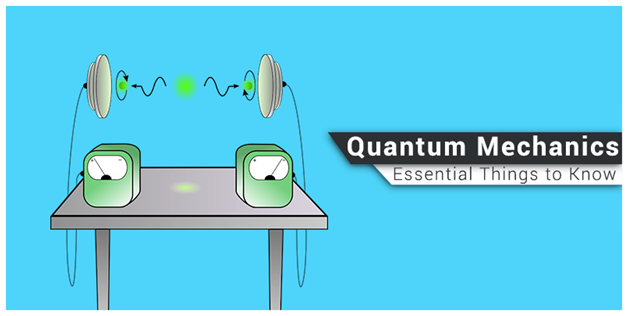
Most people hear this term tossed around sometime or the other. This post will cover the basic properties and essential things that one should know if they want to comprehend Quantum Mechanics.
History of Quantum Mechanics
The history of quantum mechanics is an important part of the history of modern physics. The term “Quantum Mechanics” was coined by a group of physicists including Max Born, Wolfgang Pauli and Werner Heisenberg in the early 1920s at the University of Göttingen. Both matter and radiation have characteristics of waves and particles at the fundamental level. The gradual acknowledgment by scientists that matter has wave-like properties and radiation has particle-like properties provided the momentum for the development of quantum mechanics.
What is Quantum Mechanics?
Quantum mechanics is the branch of physics that deals with the behavior of matter and light on a subatomic and atomic level. It attempts to explain the properties of atoms and molecules and their fundamental particles like protons, neutrons, electrons, gluons, and quarks. The properties of particles include their interactions with each other and with electromagnetic radiation. So below mentioned are those two pointers one should know necessarily before tackling quantum mechanics.
Quantum Mechanics Formulas
Following are the list of few formulas that are used in quantum mechanics:
| Quantity | Formula |
| Wavefunction probability density | \(\begin{array}{l}\rho =\left |\Psi \right |^{2}=\Psi *\Psi\end{array} \) |
| Photoelectric equation | Kmax=hf+Φ |
| Hydrogen atom spectrum | \(\begin{array}{l}\frac{1}{\lambda }=R(\frac{1}{n_{j}^{2}}-\frac{1}{n_{i}^{2}})\end{array} \) , nj<ni |
| Dipole moment potential | U=-μB=-μzB |
Quantum Mechanics is Everywhere
It’s extremely difficult to notice the quantum effects when large bodies come into play. All things obey the quantum mechanics laws. This was the reason why quantum physics was explored later in theoretical chemistry. Until the physicist had to find an explanation for the shells in which the electron sits around the nucleus, they had no use for quantum mechanics.
It is an Area of Active Research
Dismissing quantum mechanics as a thing of the past will be a mistake. Agreed that the theory was coined a century before but due to the lack of modern instruments, research into it was at a primitive state. Quantum mechanics has been applied and accepted into many fields such as optics, computers, thermodynamics, cryptography, and also meteorology. Research in these fields is still active.
Information is Never Conveyed Non-Locally
Things appear and disappear at random, but they don’t just travel over stretches of space without going through all the things in between. In the hay-days of quantum mechanics, this confusion was a great one but now it has been proved that this theory fits in perfect compatibility with the theory of special relativity. This tells us that entanglement, although a non-local phenomenon, does not have any action.
It was not Denied by Einstein
Quantum mechanics was not denied as a theory by Einstein, although many people have the misconception. He could not have denied the theory as it was successful on such a large scale. What Einstein said was that the theory was incomplete and it was his belief that the random processes of quantum mechanics may have an explanation to them.
Schrodinger’s Cat is either Alive or Dead. Surely not both
Macroscopic bodies lose their quantum behavior very fast. This was never well understood by the scientists of that time. This happens because of the regular interactions the body would have to endure. Quantum mechanics has been exceptionally successful in explaining microscopic phenomena in all branches of physics.
Stay tuned with BYJU’S to learn more about quantum physics, and much more.
The video about the fundamentals of electromagnetism

Frequently Asked Questions – FAQs
What is quantum mechanics?
What is electromagnetic radiation?
Define wavelength.
c = λ ν

Comments